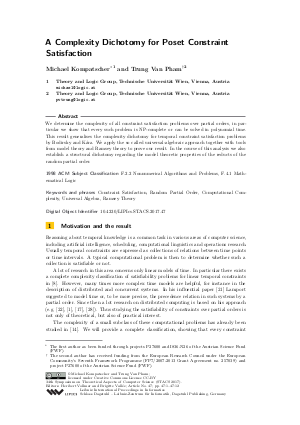A Complexity Dichotomy for Poset Constraint Satisfaction
Authors Michael Kompatscher, Trung Van Pham
-
Part of:
Volume:
34th Symposium on Theoretical Aspects of Computer Science (STACS 2017)
Part of: Series: Leibniz International Proceedings in Informatics (LIPIcs)
Part of: Conference: Symposium on Theoretical Aspects of Computer Science (STACS) - License:
 Creative Commons Attribution 3.0 Unported license
Creative Commons Attribution 3.0 Unported license
- Publication Date: 2017-03-06
File

PDF
LIPIcs.STACS.2017.47.pdf
- Filesize: 479 kB
- 12 pages
Document Identifiers
Subject Classification
Keywords
- Constraint Satisfaction
- Random Partial Order
- Computational Complexity
- Universal Algebra
- Ramsey Theory
Metrics
- Access Statistics
-
Total Accesses (updated on a weekly basis)
0PDF Downloads0Metadata Views
Abstract
We determine the complexity of all constraint satisfaction problems over partial orders, in particular we show that every such problem is NP-complete or can be solved in polynomial time. This result generalises the complexity dichotomy for temporal constraint satisfaction problems by Bodirsky and Kára. We apply the so called universal-algebraic approach together with tools from model theory and Ramsey theory to prove our result. In the course of this analysis we also establish a structural dichotomy regarding the model theoretic properties of the reducts of the random partial order.
Cite As Get BibTex
Michael Kompatscher and Trung Van Pham. A Complexity Dichotomy for Poset Constraint Satisfaction. In 34th Symposium on Theoretical Aspects of Computer Science (STACS 2017). Leibniz International Proceedings in Informatics (LIPIcs), Volume 66, pp. 47:1-47:12, Schloss Dagstuhl – Leibniz-Zentrum für Informatik (2017)
https://doi.org/10.4230/LIPIcs.STACS.2017.47
BibTex
@InProceedings{kompatscher_et_al:LIPIcs.STACS.2017.47,
author = {Kompatscher, Michael and Pham, Trung Van},
title = {{A Complexity Dichotomy for Poset Constraint Satisfaction}},
booktitle = {34th Symposium on Theoretical Aspects of Computer Science (STACS 2017)},
pages = {47:1--47:12},
series = {Leibniz International Proceedings in Informatics (LIPIcs)},
ISBN = {978-3-95977-028-6},
ISSN = {1868-8969},
year = {2017},
volume = {66},
editor = {Vollmer, Heribert and Vall\'{e}e, Brigitte},
publisher = {Schloss Dagstuhl -- Leibniz-Zentrum f{\"u}r Informatik},
address = {Dagstuhl, Germany},
URL = {https://drops.dagstuhl.de/entities/document/10.4230/LIPIcs.STACS.2017.47},
URN = {urn:nbn:de:0030-drops-69850},
doi = {10.4230/LIPIcs.STACS.2017.47},
annote = {Keywords: Constraint Satisfaction, Random Partial Order, Computational Complexity, Universal Algebra, Ramsey Theory}
}
Author Details
References
-
Frank D. Anger. On Lamport’s interprocessor communication model. ACM Transactions on Programming Languages and Systems (TOPLAS), 11(3):404-417, 1989.

-
Libor Barto and Michael Pinsker. The algebraic dichotomy conjecture for infinite domain constraint satisfaction problems, 2016. preprint, arXiv:1602.04353, to appear in the proceedings of LICS 2016.

-
Manuel Bodirsky. The core of a countably categorical structure. In STACS 2005, pages 110-120. Springer, 2005.

-
Manuel Bodirsky. Complexity classification in infinite-domain constraint satisfaction, 2012. Mémoire HDR à l'Université Paris 7, arXiv:1201.0856v7.

-
Manuel Bodirsky, Hubie Chen, Jan Kára, and Timo von Oertzen. Maximal infinite-valued constraint languages. Theoret. Comput. Sci., 410(18):1684-1693, 2009.

-
Manuel Bodirsky, Peter Jonsson, and Trung Van Pham. The complexity of phylogeny constraint satisfaction. In STACS 16, 2016.

-
Manuel Bodirsky and Jan Kára. The complexity of equality constraint languages. Theory of Computing Systems, 43(2):136-158, 2008.

-
Manuel Bodirsky and Jan Kára. The complexity of temporal constraint satisfaction problems. Journal of the ACM, 57(2):Art. 9, 41, 2010.

-
Manuel Bodirsky, Barnaby Martin, Michael Pinsker, and András Pongrácz. Constraint satisfaction problems for reducts of homogeneous graphs, 2016. Preprint, arXiv:1602.05819.

-
Manuel Bodirsky and Jaroslav Nešetřil. Constraint satisfaction with countable homogeneous templates. Journal of Logic and Computation, 16(3):359-373, 2006.

-
Manuel Bodirsky and Michael Pinsker. Reducts of Ramsey structures. AMS Contemporary Mathematics, vol. 558 (Model Theoretic Methods in Finite Combinatorics), pages 489-519, 2011.

-
Manuel Bodirsky and Michael Pinsker. Schaefer’s theorem for graphs. J. ACM, 62(3):19:1-19:52, 2015.

-
Manuel Bodirsky, Michael Pinsker, and Todor Tsankov. Decidability of definability. Journal of Symbolic Logic, 78(4):1036-1054, 2013.

-
Mathias Broxvall and Peter Jonsson. Point algebras for temporal reasoning: Algorithms and complexity. Artificial Intelligence, 149(2):179-220, 2003.

-
Peter Cameron. Transitivity of permutation groups on unordered sets. Mathematische Zeitschrift, 148:127-139, 1976.

-
Tomás Feder and Moshe Y. Vardi. The computational structure of monotone monadic SNP and constraint satisfaction: a study through Datalog and group theory. SIAM Journal on Computing, 28:57-104, 1999.

-
Patrice Godefroid, J. van Leeuwen, J. Hartmanis, G. Goos, and Pierre Wolper. Partial-order methods for the verification of concurrent systems: an approach to the state-explosion problem, volume 1032. Springer Heidelberg, 1996.

-
Wilfrid Hodges. A shorter model theory. Cambridge University Press, Cambridge, 1997.

-
Peter Jeavons. On the algebraic structure of combinatorial problems. Theoretical Computer Science, 200(1):185-204, 1998.

-
Michael Kompatscher and Trung Van Pham. A complexity dichotomy for poset constraint satisfaction, 2016. Preprint, arXiv:1603.00082.

-
Leslie Lamport. Time, clocks, and the ordering of events in a distributed system. Communications of the ACM, 21(7):558-565, 1978.

-
Leslie Lamport. The mutual exclusion problem: Part I - A theory of interprocess communication. Journal of the ACM, 33(2):313-326, 1986.

-
Péter Pál Pach, Michael Pinsker, Gabriella Pluhár, András Pongrácz, and Csaba Szabó. Reducts of the random partial order. Advances in Mathematics, 267:94-120, 2014.

-
Péter Pál Pach, Michael Pinsker, András Pongrácz, and Csaba Szabó. A new operation on partially ordered sets. Journal of Combinatorial Theory, Series A, 120:1450-1462, 2013.

-
Madelaine Paoli, William T. Trotter, and James W. Walker. Graphs and orders in Ramsey theory and in dimension theory. In Graphs and Order, pages 351-394. Springer, 1985.

-
Michael Pinsker. Algebraic and model theoretic methods in constraint satisfaction, 2015. preprint, arXiv:1507.00931.

-
Thomas J. Schaefer. The complexity of satisfiability problems. In Proceedings of the tenth annual ACM symposium on Theory of computing, pages 216-226. ACM, 1978.

-
Andrew S. Tanenbaum and Maarten Van Steen. Distributed systems. Prentice-Hall, 2007.

-
Simon Thomas. Reducts of the random graph. The Journal of symbolic logic, 56(01):176-181, 1991.

